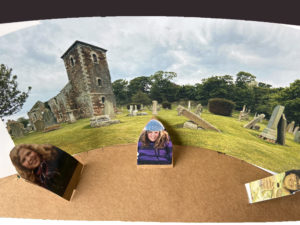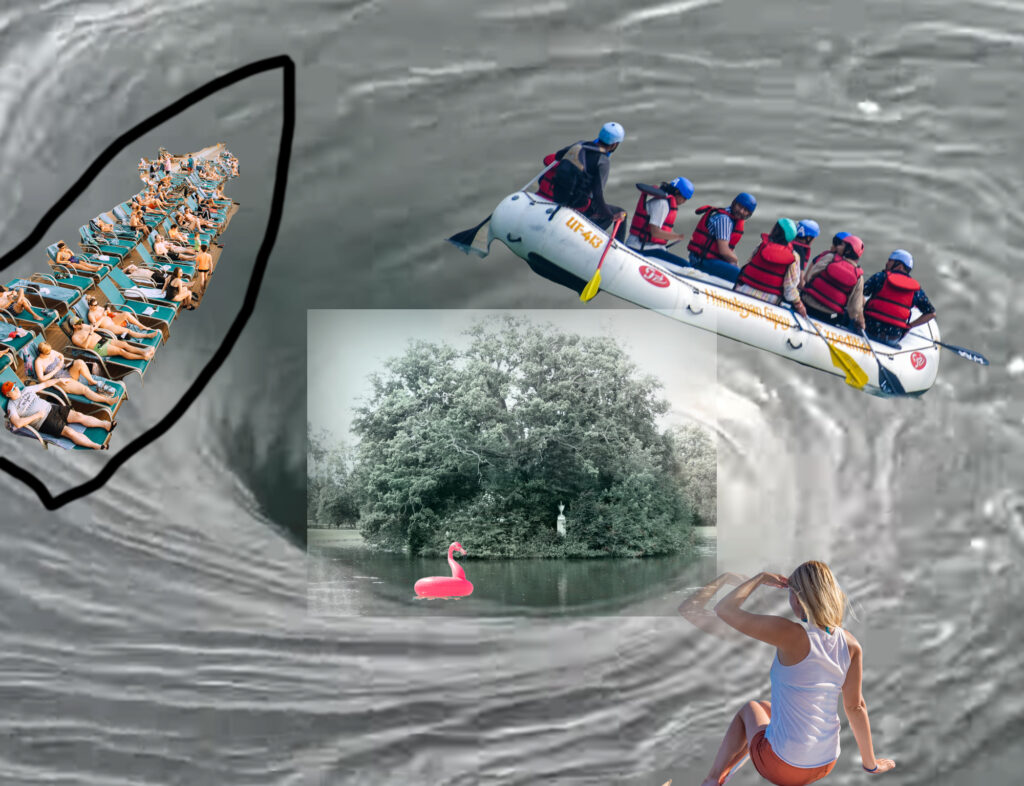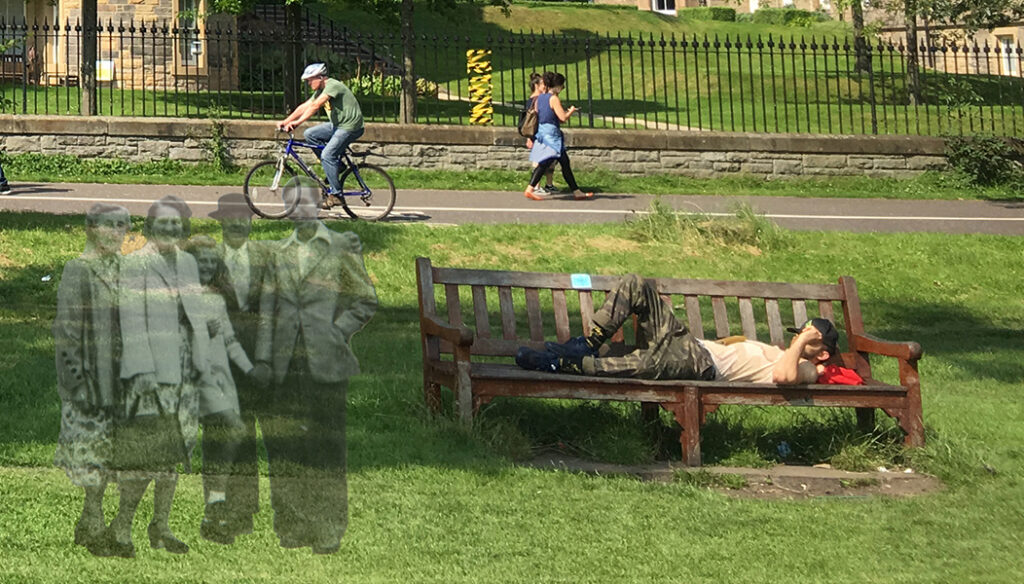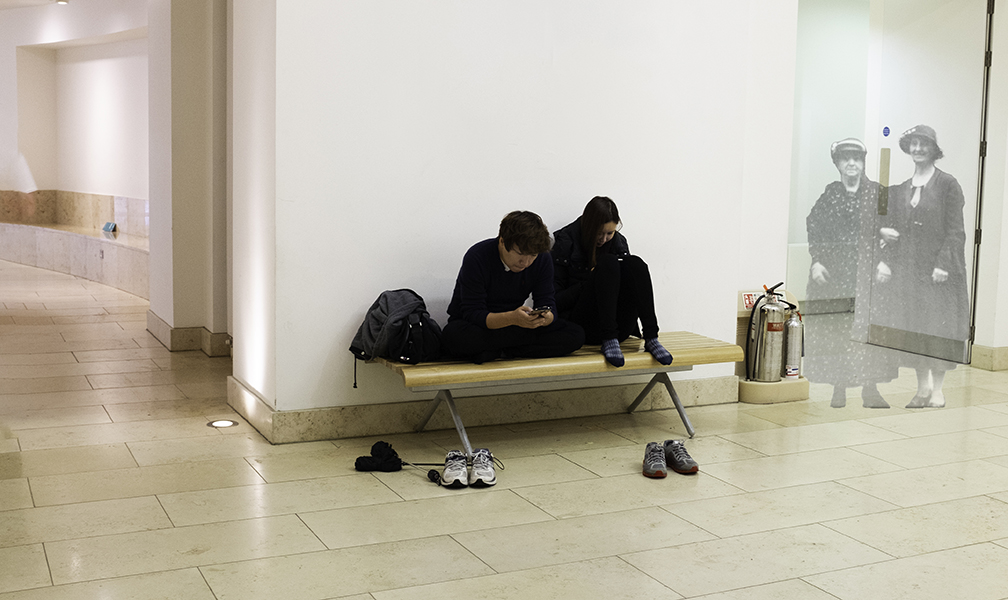Based on feedback from last month this is a more linear version of my creative work.
Starting from my work done on this project at the end of level 2 I started exploring the medical scan and wondered how I could use these in my work. The scans I use, I had requested from the NHS and show images of my son and daughter and their cancers so there is aways a huge emotional component with my work. The scans I used were removed from the medical setting to the walls of an art gallery and to create works based on the idea of children’s games.

Medical Scans as Games #01

Medical Scans as Art #04

Medical Scans as Art #03

Medical Scans as Games #02
These early works were visual trials into how I felt about using medical scans of my children in my creative works. These early test pieces in part about testing different techniques but also dealing with the questions and doubts my work raised within myself.
In this current year of study I started to build a more complete idea on my work linking my research interests with my creative works. My first works produced within level 3 serve as an initial outline where I introduced my daughter through two works as I felt my work from last year around the scan missed out the person behind the scan.
Part 1 is a 4 minutes 20 seconds slideshow of the images I collected from Rebecca’s phone after she died. The series consists of screenshots, photographs and artworks mostly captured or created by Rebecca sometimes but also sometimes pictures there taken by others including by me. I run sequence quickly as I don’t want audience to concentrate on any one image over another but instead wanted to give the impression of the passage of time. Also fast, because imagine a 17-year-old who knows they are dying and is trying to cram in as much as possible when their treatment and their pain management allows.
Part 2 is the same period but from my perspective of a parent with a camera. I have taken time to consider which images to show and how to display them and placed the images with text and with blank space to create a sense of reflection which allows viewer to step through this collection at their own pace, stopping to read my words. This is a slow work designed with time and space to think. With that increase in time, the sense of pain and loss can increase as we have more time to dwell.
My work is contained within a book saved in PDF format and available in the link below.
Part 2 – A Retrospective on my Daughter Rebecca
My next test works were more haptic in nature built on my experiences of creating works in level 2. My first based upon the idea of fragmentation. The second looking at tumble down gravestones alongside cut out images of my daughter as if she was representing a grave marker. I am first to admit that these attempts were unsuccessful. Visually the concept didn’t hang together and these works didn’t capture any of the emotion which I feel is important in my project. I think it was an error on my part using photographs where my daughter was smiling as this created a disconnect with my concept

Haptic test piece#03

Haptic test piece#04
At this point in my studies I had reached the mid-point of this unit and there seemed to be a development which might be attributed to an increased understanding of my subject. I wondered about my daughter and who would remember her and indeed who would remember me once I was dead. I would be forgotten. I stopped worrying about direct imaged of medical scans or of my daughter and considered symbolism around death and the gravestone itself and what that says of the person it commemorates. Using this idea of forgotten people in forgotten graves, I tried to re-imagine graves of famous people. I used an image of Street Artist Jean-Michel Basquiat’s rather plain gravestone which to me said nothing of this man. I overlaid it with one of his own graffiti images. It felt to me that my rendition of his grave gave a more complete sense of the real person who was remembered by that gravestone. I was starting to explore death, memory and memorials.

Jean-Michel Basquiat Grave Re-imagined
My next attempt re-imagines the grave of Karl Marx which is in London’s Highgate Cemetery.
I introduced cracks into the stone and show the grave overgrown with plants. My choice of plants includes the Yew which has mythological connection to death. To the Celtic people the yew was seen as a gateway between life and death. I also added moss over Marx’s head which seemed t sum up idea of teh plant seeking succour from the source of his ideas.

Kark Marx’s Grave aged and forgotten
I imagined people in the future rarely visiting this space and wonder what they might think of this grave with a carved head overgrown with moss. Karl Marx is familiar to us but might not always be familiar.
Through my use of this famous gravestone I aim to encourage thoughts about the memories of people who had no fame in their lifetime. If even Marx’s grave can decay to become anonymous, then the same can happen to the memory of every one of us.
My third test piece this month explores graveswhere the grave been damaged or worn and attempts to present a new story. I positioned a found photograph onto wall where grave slab once sat and scratched out all bar one of the faces on the image.

Unkown Grave with Scratched Photograph
The work below takes an unknown grave where the sandstone been eroded and no sense of who is memorialised here remains. I have added in graffiti comments on the computer.

Unknown Grave with Graffiti
My next creative works came the following month after some very helpful feedback that some of my work was seen as being literal and some more philosophical. Literal work allows less space for the audience to form their own ideas and opinions and to make their own sense of my work. My tutor described this as beginning and ending with the description of the idea. This was something I thought about quite a lot. it was obvious on reflection that my piece showing grafitti on a grave had no depth to it beyond the words.

Island burial within the grounds of Althorp Park
This worked explored the idea of an island where Princess Diana is buried and imagined the space as a water park when the significance of island been lost. I used this idea to interrogate the idea of loss set against time, fading memories and changing opinions. I think this work once more strays into area of being too literal.
My next work abandoned a sense of the grave and looked from a symbollic view. Wilhelm Conrad Roentgen discovered x-rays in the 1890s. As I looked into Roentgen’s history, I was struck by the word exposure. A simple word which made me think of a photographic exposure or the exposure to potentially lethal radioactivity or the exposure to loss and how it changes us. The first x-ray Roentgen produced is that of the hand of his wife showing her finger bones and the ring she was wearing.

Roentgen Memorial
Roentgen’s family grave is just another unremarkable grave so I wondered about using the x-ray combined with the image of his wife’s hand and the x-ray of a plant which are often used as symbollic of death. Feedback on this was that it would be interesting to strip away the x-ray monitor, the hand and just have a series on x-rays of plants.
My final creative work in this month was a layered image. This shows an unknown grave in a local graveyard. I took a series of images and have layered these as a way of implying that a graveyard isn’t really a fixed image seen at one instant in time but is a series of views and of memories none of which neatly blends or sits at comfort with other memories of a scene. At the centre of image I have placed a hand held dressing mirror with broken glass at the base of the gravestone.

Grave with Mirror
The mirror allows us to look at ourselves and when placed on a grave, asks the living to look at their reflection and to consider their mortality. In this, I was influenced by Batchen with the death memorial of a dressing mirror with photograph of the dead. In his example, the mirror was part of a domestic scene whereas mine is used in a place linked with death. The broken glass in my mirror signifies the imperfection in the photographic image and that it can never convey an entire, complete image of a whole person. Similarly, the memory of anyone is a fragment of the whole.
I have shown my shadow in the image as if my shadow was a sense of the person in the grave underneath the turf.
In my final image in this cirrent submission I explored the idea of family memory. I photographed a local memorial bench with plaques.

Memorial Bench with Family Wedding
The bench faces the sea but I have photographed it looking backwards towards the land. Behind the bench I have placed a family wedding photograph from a collection I purchased online and where I do not know any of the lost people in the image. The people are also facing the sea. I have always found it strange that if I sit in such seats I lean against the message which is then hidden from me. It might be said I am sharing the view with the dead as if they sitting beside me. In my image I imagine the wedding group sharing that same view. As they are behind me if I was in that seat, it speaks of those who went before but there is also that sense of figures behind and feeling of hairs standing up on the back of my neck. One other thing about this image is the worn ground in front of the bench, stripped of grass down to the sandy soil. I debated putting something into this space but left it bare. It reminded my of freshly disturbed ground as if for newly dug grave.
At this point in my project I decided to choose a single idea and to progress with this idea so as to explore my creative subject in more depth. In each of these I take a photograph of a bench and to it add a transparent found image from a family album I purchased online. My images explore the memories attached to each bench and to the story behind the plaque or to the people using the bench if there is no plaque as with the shot in the museum. I create a new story with my choices of the transparent image from the album. I mix in some people from today who are using the benches and weave them into my stories.
My final work in this sequence shows a child but I have aimed for a far simpler image. This shows a child with a book looking back towards camera and positioned in the frame as if was leaning book on the seat of the bench. Once again there is a scattering of autumn leaves which seems to work alongside the worn wood of the bench. It feels to me that this image is more direct than my previous attempt with the pram. The child seen on it’s own speaks of loss on different levels whether as a child mourning a lost mother or a child lost and looking back for a parent. This image, to my mind, has a chill to it.
Since I planned and made this set of images I have found some more old album photographs and in addition am waiting on some winter weather for some more photographs so that for next year I will have enough source material for wherever this project leads next.

Memorial Bench with Family and Child’s Pram

Memorial Bench with Sleeping Man

Museum Bench with Couple

Memorial Bench with Family Group and Autumn Leaves


Memorial Bench with Child and Book